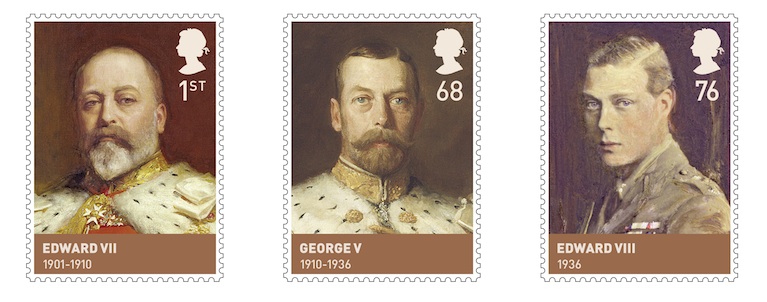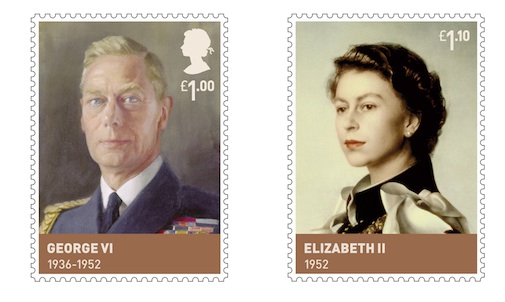Norvic Philatelics - GB New Stamps and Special Postmarks
The Houses of Saxe-Coburg & Windsor - 2 February 2012 - stamps
and miniature sheet
It
began four years ago, now Royal Mail’s epic Kings and Queens series
reaches its conclusion with the final Royal House – the House of Windsor
(and Saxe-Coburg-Gotha).
The issue features the five monarchs since the start of the 20th century,
culminating in Her Majesty Queen Elizabeth II, who celebrates her Diamond
Jubilee in 2012 – the only other monarch to achieve this
was Queen Victoria in 1897. The House of Windsor (and
Saxe-Coburg-Gotha which preceded it) has reigned for over 100 years, against
a backdrop of great events and massive change. During this time it also
faced a major constitutional challenge following the abdication of Edward
VIII.
Queen Victoria adopted the Saxe-Coburg-Gotha name on her marriage to Prince
Albert in 1840, making her eldest son, Edward VII, the first monarch to
accede to the throne under the new name in 1901. However, in 1917 at the
height of First World War, Edward’s son George V issued a royal proclamation
that changed the name of the royal house to Windsor in response to
anti-German sentiment and to emphasise the Britishness of the
monarchy. His eldest son, Edward VIII, became King in January 1936 but
reigned for less than a year before abdicating in favour of marriage to
Wallace Simpson. His younger brother Prince Albert acceded to the throne as
George VI and on his death in 1952, his eldest daughter became Elizabeth II.
|
|
1st
class: Edward VII (1901-1910)
68p George V (1910-1936)
76p – Edward VIII (1936)
£1.00 George VI (1936-1952)
£1.10 – Elizabeth II (1952-)
|
|
|
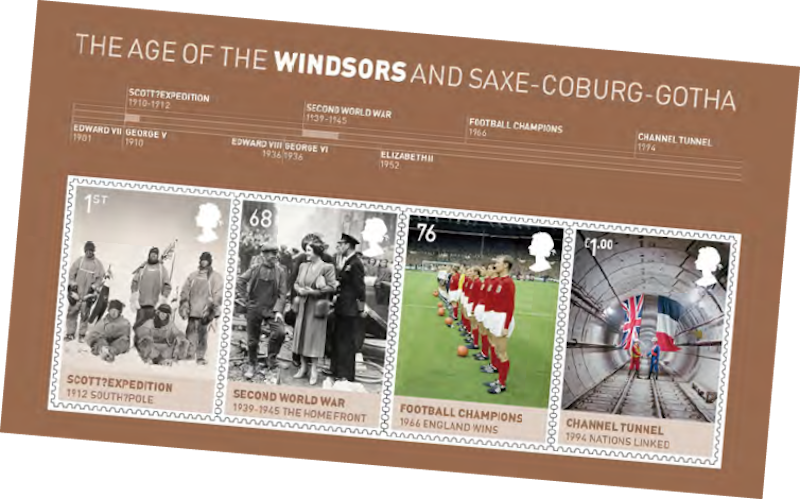
|
The MS takes a separate look at the life and times of the age,
featuring events and individuals from the reigns.
The events featured are:
1st Class: Scott Expedition –
1912
South Pole
68p: Second World War –
1939–1945
the Home Front
76p: Football Champions – 1966
England Win
£1.00: Channel Tunnel – 1996
Nations Linked
The border design features a timeline of the period. The
image is a design mock-up and contains a number of errors,
which were corrected before printing.)
|
| Acknowledgements:
Edward
VII,
1902, and George V,
c.1911, by Sir
Luke Fildes, The Royal Collection © 2011 Her Majesty Queen
Elizabeth II; Edward
VIII, c.1920,
Reginald Grenville Eves © National Portrait Gallery, London; George
VI, c.1949–52,
Denis Quintin Fildes © reserved/The Royal Collection; Queen
Elizabeth II (b.1926), 1954 (oil on canvas),
Fishmongers’ Hall, London, UK/The Bridgeman Art Library,
portrait by Pietro Annigoni, Camera Press London. |
Background on the stamps
1st Class – Edward VII (1901-1910)
Edward VII was the first British
monarch of the House of Saxe-Coburg and Gotha. During the widowhood of
his mother, Queen Victoria, he was largely excluded from political power
and came to personify the fashionable, leisured elite.
The Edwardian era, coincided with
the start of a new century and heralded significant changes in
technology and society. Edward played a role in the modernisation of the
Royal Navy and the reorganisation of the Army after the Second Boer War.
He fostered good relations between the UK and other European countries,
especially France, for which he was popularly called “Peacemaker”, but
Edward suspected that his nephew, Wilhelm II of Germany, would
precipitate a war, and four years after Edward’s death, World War I
brought an end to the Edwardian way of life.
68p – George V (1910-1936)
George was the first cousin of Tsar Nicholas II of Russia and Kaiser
Wilhelm II of Germany. From 1877 until 1891 he served in the Royal Navy.
On his father’s death in 1910, he succeeded as King-Emperor of the British
Empire. He was the only Emperor of India to be present at his own Delhi
Durbar. His reign saw the rise of socialism, communism, fascism,
Irish republicanism, and the Indian independence movement, all of which
radically changed the political landscape.
The Parliament Act 1911 established the supremacy of the elected House of
Commons of the United Kingdom over the unelected House of Lords. He
appointed the first Labour ministry in 1924, and in 1931, the Statute of
Westminster recognised the dominions of the empire as separate,
independent kingdoms within the Commonwealth of Nations. He was plagued by
illness throughout much of his later reign and at his death was succeeded
by his eldest son, Edward VIII.
76p – Edward VIII (1936)
Only months into Edward’s reign,
he caused a constitutional crisis by proposing marriage to the American
socialite Wallis Simpson, who had divorced her first husband and was
seeking a divorce from her second. The prime ministers of the United
Kingdom and the Dominions opposed the marriage, arguing that the people
would never accept a divorced woman with two living ex-husbands as
queen. Additionally, such a marriage would have conflicted with Edward’s
status as head of the Church of England, which opposed the remarriage of
divorced people if their former spouses were still alive.
Edward knew that Stanley Baldwin’s
government would resign if the marriage went ahead, which could have
dragged the King into a general election and ruined irreparably his
status as a politically neutral constitutional monarch. Rather than give
up Mrs. Simpson, Edward abdicated. He was succeeded by his younger
brother Albert, who chose the regal name George VI. With a reign of 325
days, Edward was one of the shortest-reigning monarchs in British
history. He was never crowned. After his abdication, he was created Duke
of Windsor.
£1.00 – George VI (1936-1952)
As the second son of King George V, he was not expected to inherit the
throne and spent his early life in the shadow of his elder brother, Edward.
He served in the Royal Navy during World War I, and after the war took on
the usual round of public engagements. He married Lady Elizabeth Bowes-Lyon
in 1923, and they had two daughters, Elizabeth and Margaret.
When George’s elder brother abdicated in order to marry Wallis Simpson in
1936 George ascended the throne as the third monarch of the House of
Windsor. On the day of his accession, the parliament of the Irish Free State
removed the monarch from its constitution. Further events during George’s
reign accelerated the break-up of the British Empire and its transition into
the Commonwealth of Nations. Three years after his accession, the Empire and
Commonwealth, was at war with Nazi Germany. Though Britain and its
allies were ultimately victorious, the United States and the Soviet Union
rose as pre-eminent world powers and the British Empire declined. After the
independence of India and Pakistan in 1947, his title of Emperor of India
was abandoned in June 1948. Ireland was formally declared a republic in
1949, and India followed suit the following year. George adopted the new
title of Head of the Commonwealth. He was beset by health problems in the
later years of his reign.
£1.10 – Elizabeth II (1952)
Elizabeth II is the constitutional monarch of the United Kingdom,
Canada, Australia, New Zealand, Jamaica, Barbados, the Bahamas, Grenada,
Papua New Guinea, the Solomon Islands, Tuvalu, Saint Lucia, Saint Vincent
and the Grenadines, Belize, Antigua and Barbuda, and Saint Kitts and Nevis.
As Head of the Commonwealth, she is the figurehead of the 54-member
Commonwealth of Nations; as the British monarch, she is the Supreme Governor
of the Church of England.
Elizabeth was educated privately at home. Her father ascended to the throne
as George VI in 1936. Elizabeth began to undertake public duties during the
Second World War, in which she served in the Auxiliary Territorial Service.
When her father died in 1952, Elizabeth, aged 25, became Head of the
Commonwealth and queen of seven independent Commonwealth countries. Her
coronation service in 1953 was the first to be televised. In 1947, she
married Prince Philip, Duke of Edinburgh, with whom she has four children:
Charles, Anne, Andrew, and Edward and eight grandchildren. The Queen,
together with Prince Phillip,
continues to carry out hundreds of official duties every year and still
remains patron of around 600 charities.
Miniature
Sheet
1st Class: Scott Expedition – 1912 South Pole
Captain Robert Falcon Scott of the Royal Navy led an expedition to
the South Pole, which he and his four-man team reached on 17 January
1912, only to find that they had been beaten by a Norwegian expedition
33 days previously. On their way back to camp, through appalling
blizzards, they were assailed by exhaustion, malnutrition and frostbite,
and all sadly perished. The stamp marks the centenary of Scott’s team
reaching the South Pole in one of the most famous expeditions in British
history.
68p: Second World War – 1939–1945 the Home
Front
The Royal Family was tireless in its efforts to maintain domestic morale
throughout the Second World War, especially during the Battle of Britain and
the Blitz in 1940–41. When Buckingham Palace was hit by the Luftwaffe on 13
September 1940, with two bombs exploding only 30 yards from the King, Queen
Elizabeth the Queen Mother remarked that now “she could look the East End in
the face”. Fittingly the stamp shows the Queen Mother during a tour of
bomb-damaged London.
76p: Football Champions – 1966
England Win
On 30 July 1966, in front of 93,000 spectators, the England football team
made history at Wembley Stadium, becoming world champions after beating West
Germany 4-2. After 90minutes the score was 2-2, but two extra-time goals
from striker Geoff Hurst gave England victory on home soil. Queen Elizabeth
II presented the jubilant players with the winners’ trophy.
£1.00: Channel Tunnel – 1996 Nations
Linked
The two ends of the Channel Tunnel met in December 1990 and it was
officially opened on 06 May 1994. On that day in Calais, Queen Elizabeth II
and the French President François Mitterrand attended the inauguration after
the Queen’s arrival in France on a Eurostar train. Later, she and Mitterrand
travelled on a Le Shuttle train to an identical ceremony at Folkestone,
Kent. The Channel Tunnel remains one of the
outstanding engineering achievements of the 20th century, and this symbolic
joining of nations is a fitting end to the Kings and Queen’s stamp series.
Technical details:
The designs are by Atelier Works,
and the 27 x 37mm stamps are printed in lithography by Cartor Security
Printers, Meacé, France, in sheets of 25/50, perf 14 x 14.
The miniature sheet is 123 x 70mm, also perf 14 x 14.
All images are Copyright Royal Mail 2011/2.
Products available from Royal Mail:
Mint set -- Mint miniature sheet -- Press Sheet of 21 uncut MS --
Presentation Pack (set & MS)
Set on PO FDC and MS on PO FDC -- Set of 10 Stamp Cards -- Cachet Cover
Special Postmarks
Postmarks available for the day of issue will be shown here, these may
not be to scale. These postmarks cannot be obtained after the date
of issue.
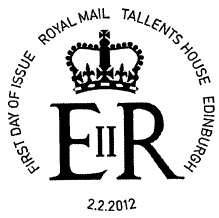
|
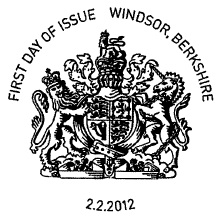
|
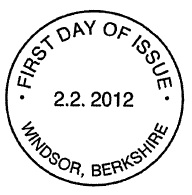
|
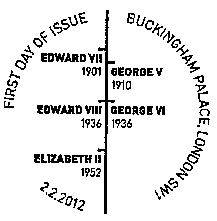 |
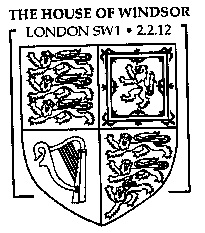 |
Ref FD1205
Philatelic Bureau Official Postmark |
Ref FD1206
Windsor Official Postmark |
Ref FD1206N Windsor non-pictorial postmark. |
Ref L12389 First day of issue Buckingham Palace, London
Timeline postmark |
Ref L12394 London SW1 |
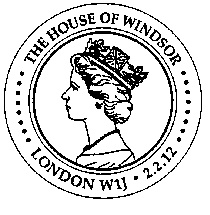
|
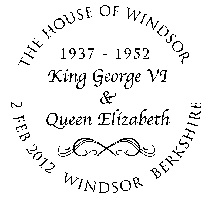 |
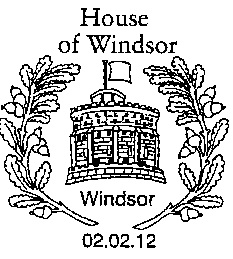 |
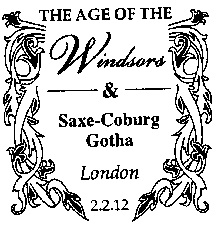 |
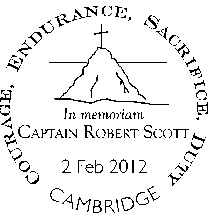 |
Ref L12395 London W1
|
Ref L12391
1937-1952 King George VI & Queen Elizabeth, Windsor
|
Ref L12390 Windsor |
Ref L12393
The Age of the Windsors & Saxe-Coburg Gotha, London
|
Ref L12392 Courage, Endurance, Sacrifice, Duty, In memoriam
Captain Robert Scott, Cambridge
|
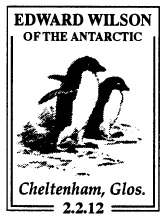 |
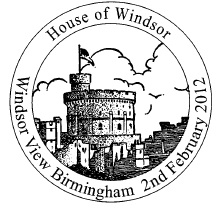 |
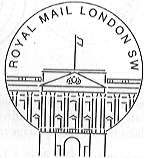 |
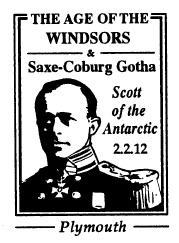
|

|
Ref M12403 Edward Wilson of the Antarctic, Cheltenham Glos
|
Ref M12401
Windsor View Birmingham
|
Ref L4666
Buckingham Palace, London SW
|
RefW12406 Scott of the Antarctic, Plymouth
|
Ref L4680 Windsor Castle
|
If you would like to know when this page is updated, please use the
ChangeDetection panel next to the stamp images.
If you have any questions about these stamps please email
us.
NB: all emails should be acknowledged in 1-2 days unless
the office is closed. If you do not receive an acknowledgement please
email us from a different address (eg hotmail, gmail).
This page updated 13 January 2012
Instant
Printing Prices from Webmart
